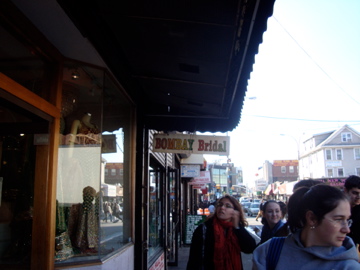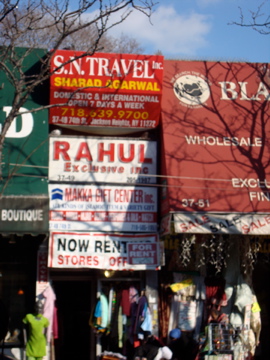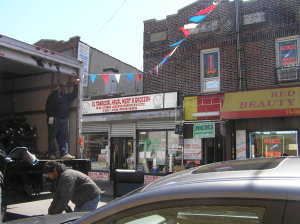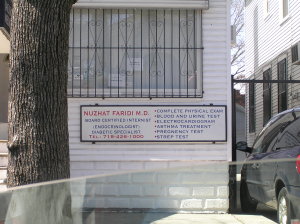From The Peopling of New York City
Contents |
Culture Contact
If you’re in a group and someone different comes, of course you’re going to look and question them for a second. You’re going to have that little doubt. -Maya, Interview
* Jackson Heights is an extremely diverse neighborhood of New York City. In its center is a mostly South Asian shopping center, but its population varies greatly in ethnicity, religion, and culture. Religiously it contains Hindus, Muslims, Christians, and several other religions. Some nationalities present are Indians, Bengalis, Tibetans, Pakistanis, Asians, as well as several types of Hispanics. The cultures of these various immigrant populations ranges tremendously and yet they all live and work in very close proximity. How do these different cultures interact with each other? Do they mix with each other or do they prefer to remain separate? Are there religious or ethnic tensions among these different immigrants? Transnationalism and culture contact are very common in the United States and especially in New York, and it is interesting to see how this pertains to the South Asian immigrant population and to this unique mix of people in Queens. These questions are often controversial and personal as ethnic tensions and differences are not always easy to talk about and admit in public. Relations among different types of people also varies depending on religion, nationality, and especially personal traditons and family dynamics. It is therefore interesting to compare the different opinions on these relations, and find out what problems arise from these differences. Most importantly, is the new and growing youth population changing the dynamic among these differing population and creating a more tolerant and peaceful community? And is assimilation and Americanization of this youth causing a “culture loss” as some parents might fear? Our group’s research will focus on these several ethnic relationships between the different peoples of Jackson Heights, and on how the life of immigrants in New York City reflects these relations.
Individual Research Topics
In my paper, I hope to describe the changes I have seen in Jackson Heights from the first paper I read to my most recent interview. In interviewing Maya, a student and child of South Asian parents, I have noticed how her family has accepted those of different race and religion and grown in appreciation for the very mixed cultures of America. Her grandparents, although traditional, allowed her uncle to marry on his own will, and Maya herself plans to follow her own heart. Are assimilation and relaxation of strict South Asian beliefs opening doors for the South Asian youth to welcome and accept those outside their culture norms? Temples, restaurants, and grocery stores are more welcoming to those of other ethnicities (beyond some dirty looks and the "What are they doing here?" question). However, bias still thrives in the workplace. Business owners continue to hire in their own ethnicity. Could this new wave of youth acceptance and tolerance break down the belief that only South Asian workers can be trusted?
In my section of this page I plan to research the interactions between the different people in Jackson Heights. I want to primarily focus on studying the interactions between the Pakistanis and the Indians. I will also try and find the role of the Tibetans and the Bangladeshis in this community. While studying these groups I plan on identifying what sort of interactions exist between them. I also want to further research why the different peoples behave the way that they do towards each other, whether this is due to race, religion, or because of conflicting cultures? Also if no tension exists, why is this so? What allows these very different people to leave in peace with each other?
My research pertains the various religious groups in Jackson Heights and how each of these can coexist in one compact area without noticeable disputes or major conflicts. How can a conspicuously Hindu Indian shop selling Ganesha idols juxtapose a Muslim street vendor selling religious placards and Islamic books? My research investigates the interpersonal relationships between such vendors and people of the neighborhood. My project serves to answer the question: Does religious tension factor into the lives of South Asians in Jackson Heights and how does it affect the neighborhood’s stability? To answer this question, I interviewed three main subgroups: a religious leader, Jackson Heights residents and religious store owners/vendors. It is important to discuss tensions in the neighborhood to explore how life in India has impacted the thoughts and behaviors of Indians in America who must interact with one another on a daily basis.
I will research the role of Islamic institutions or Islamic related buildings or organizations within Jackson Heights. I find out to what extent Islam manifests itself within the Jackson Heights neighborhood and community and what role the Islamic literature vendors and the Mosque on 73rd Street play within the neighborhood. I will accomplish this from my interview with a member of the Mosque in Jackson Heights, a Pakistani Muslim store owner in Jackson Heights, and talking to South Asian American Muslim teenagers who are aware of Jackson Heights.
In my section, I will research the differences and interactions between the different ethnic groups within Jackson Heights and people’s viewpoints on other cultures. I want to find out how the different cultures interact within the neighborhood and if there is any significant bias between store owners and workers. I intend to figure this out through interviews with store owners, and potentially, workers who can provide me some insight into the relations between the different cultures.
My research attempts to investigate if Indian American immigrants maintain a separate identity between those from North and South India. Do people remain separate from each other with their own traditions and rituals depending on where they are from in India, or do they join and form a combined Indian identity? Are there tensions and disagreements between North and South Indians? Is a new North and South Indian mixed culture developing amoung youth here in NY as a result of this mix? By examining interactions between Indians in Jackson heights, and by talking to Indians of different regions of India, I attempt to study this interesting and controversial question.
Interviews, Pictures, and Questions
Islamic literature vendors by Jin Woo Chung
Jin Woo Chung interviews Shahim of Mosque on 73rd
Jin Woo Chung interviews Pakistani Muslim Book Store Owner
Jin Woo Chung interviews Sameer Khan
My Interview with Maya, a student of a Catholic High School who frequents Jackson Heights
She discusses race relations, marriage, gender roles, and Bollywood.
Possible Interview with Helen Sears
Krawczyk Interview with Kanushree Jain
Marriage, Family and Gender: Blackwood, Chang, Grechtchouk, Kofman, Petimar, Polonetskya
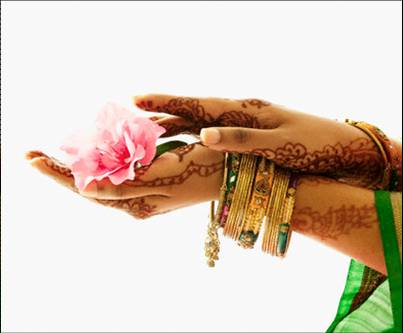
- This section will discuss the roles and value of immigrant and second-generation women of South Asian descent in the context of marriage, family, and the general society. By observing the specific neighborhood of Jackson Heights, interviewing various shopkeepers, employees, organization members, and using outside sources, we began to discover the complexities that South Asian female immigrants face in daily life. We have also tried to find connections between life in their countries of origin, immigrant family life, and second-generation life in Jackson Heights. In finding these commonalities and differences, we were able to better comprehend the cultural identity and assimilation of South Asians in this country.
Shanna Kofman and Aleksandra Polonetskaya: Female independence: “To work or not to work?”
- This section explores the connection between family and professional life, and how these two aspects of life have evolved and remained constant for Indian South Asian women in America. It will discuss the traditional roles for women in South-Asian countries, including India, Pakistan and Bangladesh, and how those roles are translated in American society. Furthermore, the role of women in business, voluntary organizations, and academia in Jackson Heights and other South-Asian communities in New York City is demonstrated.
Eileen Chang and Irene Grechtchouk: Marriage and Wedding Industry

- This section will focus on the importance of marriage in Indian culture. It will explore the traditions that are prevalent in India as well as in the United States, such as arranged marriages, the dowry system and the many aspects of the ceremony during the wedding. It will also discuss the economic impact that the wedding industry has had on the small shopping district of "little India" in Jackson Heights, Queens. It will discuss how the many businesses that have been rooted in the area for many years, rely on the industry to bring in business. How things have or have not changed throughout the years, and whether the American culture surrounding them has influenced some families to stray from the traditional Indian side into a more western wedding style.
Mia Blackwood and Joshua Petimar: Youth and Family Structure
- This section is primarily focused on the impact of immigration on the family, especially youth. Here, we are specifically observing the ways family structure and tradition are carried over from South Asia to America. We ask ourselves, "Is it possible for a family to retain all customs practiced in the home country, or will the influence of American culture inevitably penetrate through?" We are interested in studying the changing dynamic of the family, as it progresses from immigration towards assimilation. Of particular interest is the effect of this change on the youth. How do South Asian immigrants' children, who are often more heavily exposed to American culture than their parents, see themselves? Do they ever struggle with the conflicting ideologies of tradition and Americanization? This section attempts to answer these and other questions concerning changing families of South Asian immigrants.
Music, Movies & Youth Culture: Damasco, Lin, Mienko, Quevedo

Very often, culture is represented through its film and music. For South Asians, this cannot be more true; who has not heard of “Bollywood” and connected it with the Indian culture? While old time classics for Indian films, music, and dance are still enjoyed, the ever growing population of South Asians living in America has influenced many changes in film and music production. These progressions have become clearly evident on every street corner of Jackson Heights; in the form of music and DVD vendors by day, and on the dance floor as what is now known as the “Indian party scene” by night. These changes are most evident in the South Asian youth population who find it increasingly harder to identify with being just American or just South Asian. Is South Asian music and film media pulling the youth community away from American culture, or rather, is it a force creating a community that is transnationalist, such as Jackson Height's "Little India" businesses? How does music and films act as that medium connecting both worlds? By attending Indian dance parties, listening to select Bollywood pop music, watching the latest Hindi films, and interviewing certain people, we aim to define the change that is happening in the South Asian youth community, how it is reflected in music and film, and the relationship of the ethnic media to its consumers.
Interviews / Research:
Hunter College's Southasian Club Interview Questions
Indian Film Interview Questions
Interview with Cashmira Shah. KLin
Interview with Samantha Shetty: Member of Hunter's Desi Club
Running an Ethnic Business: Dire, Fox, Ilyas, Kalasapudi
"In many cases we speak the same language, we share similar experiences, and even have similar taste. It also adds a factor of trust, because it is easier to communicate. Even more, the length at which we have been shopping here we know many store owners personally."
Male Shopper in Jackson Heights
"Because of their common origins, a sense of trust is created between these people, which leads to a good business chemistry. I know several owners who say their shop benefits from sharing customers with their close neighbors."
Owner of Alankar Jewelers
"As an immigrant myself and part of a large community; this field of law is an extremely important issue in the political climate. Advocates who are passionate are necessary and a commodity for all sides of the argument."
Maryanne Tharappel
At the heart of the Jackson Heights South Asian community is the ethnic business district. Like other business districts, there are various types of stores that cater to the many needs of the community. This business district accommodates the South Asian community and as a result, many of the goods found here many seem foreign to most Americans, but are a “taste of home” to the South Asian community. For example, one of the largest supermarkets in the area, Patel Brothers, is not a traditional American supermarket. Instead, it supplies South Asian spices and produce, the same produce they would find back at home in Bangladesh, India, Pakistan, and Nepal among other South Asian countries.
Many of the stores in Jackson Heights are owned and operated by South Asians. As a result, many owners feel more comfortable hiring South Asians employees. This co-ethnic hiring is a direct result of loyalty, trust, and comfort that the South Asian customer base feels while shopping in this area. Co-ethnic employees bring cultural capital, personal assets that are not monetarily based such as language skills, knowledge of merchandise, and the knowledge of the latest South Asian popular culture.
Through our research, we hope to provide a comprehensive overview of the unique business culture and practices of Jackson Heights. We will compare the traditional American business model with the modified version found in an ethnic community like Jackson Heights. Remarkably, many stores in Jackson Heights are able to sustain success while ignoring the basic principles of business. Within this business model, we will discuss the dual businesses that are common in the area. A dual business arises when two or more business shares a space with one subletting to another. This practice increases the customer base while simultaneously saving money on rent and increasing the profits of both stores. We will also examine the working conditions of the many immigrant workers who are able to gain access to employment through their cultural capital. Finally, we will examine the prevalence of co-ethnic professionals in the area and why these professionals chose to return to the ethnic community.
South Asian Business Model
Of all the different aspects of the shopping area of Jackson Heights, one that stands out is the business placement. The custom in America is building shopping centers with different businesses independent of each other, in order to maximize the amount of consumers for the area. This choice of location seems to be the number one rule of American business, because it alleviates the difficulties of competition. However, in Jackson Heights, many businesses have opened up shop right next to or near another store that has products or services that are nearly identical. In America, this could be considered a crippling decision, and I am sure that many big business tycoons have statistics about the enormous probability of failure. However, in an ethnic neighborhood such as Jackson Heights, they are able to make it work. The question is how? How are they able to make it work so well? And what are the reasons for not branching out or eliminating their competition? Yet they are able to sustain success in this community that disregards American business philosophies.
Interview of Customers of Jackson Heights
Dual Businesses
Throughout the ethnic business district that is Jackson Heights there is a unique business tactic not seen in many traditional American shopping areas. The dual-business, a prevalent feature of this district, is a practice that arises from the mutual agreement between two individuals who have decided to share a location and join their shops in hopes of increasing their customer base, and thus, their profits. This strategy not only increases the number of customers that enter each shop, but also allows numerous stores to open up in one area and allow the owners to save money on their payments for either renting or leasing the land. Walking through Jackson Heights, one cannot help but notice the stores that are seemingly “stacked” one on top of another. This is a direct result of the dual-business scheme, and directly affects the population density of each building. This method maximizes the number of stores and individuals who can operate in one location, and therefore is highly economical because it optimizes all of the resources that are available in the area.
Interview with Jay Variety Shop and Appliances Owner
Interview with Alankar Jewelers Owner
Interview with Khera Travels Owner
Workers
Professionals in the Ethnic Community
There are countless doctors, lawyers, accountants, and other professionals who work in New York City. Moreover, almost 40% of all Indians in the United States have a master’s, doctorate or other professional degree Indian American Centre for Political Awareness. Although these professionals are vital to the South Asian community, the majority chose to work outside of the ethnic economy and ethnic community. Nonetheless, the professional community is a large part of the overall Jackson Heights area. Lawyers provide services geared towards an ethnic community like immigration services, tax assistance, among other services, in addition to real estate and matrimonial services. Additionally, there are many co ethnic doctors that tend to the various needs of the community.
These types of professionals are sometimes more advantageous to the community because of their cultural capital. Many feel more comfortable discussing their problems with people who are more similar to them. Additionally, specifically in the field of medicine, their are certain social practices and religious observances that must be taken into account prior to treatment.
Preliminary Interview- President of SABANY (South Asian Bar Association New York
Interview Questions- Doctors, Lawyers, Accountants
Interview with Maryanne Tharappel
Interview with Dr. Jagjit Singh
Food & Restaurants: Feng, Go, Jean, Xue
The importance of food within a culture cannot be understated. Food shapes the life of both its chef and its consumers. It allows for certain tastes to arise, and also is an important part of how people within that culture grow and survive. Therefore, it is always interesting to see when foods are transported across cultural lines.
Indian restaurants in America often face this problem. How do you market a food to people who have completely different values? Sometimes, marketing to a specific demographic of people solves this problem. A neighborhood like Jackson Heights is the result of the targeting of that market. However, as time goes on, the inhabitants start becoming more diverse as more immigrants come and their children become assimilated into American culture. Tastes change, and to survive, those restaurants must change with them. They start emphasizing speed, price, and quantity (like buffets).
The restaurants are now starting to specialize, though. Wanting to break free from the “Americanization” of their peers, many owners are advertising their ethnic origin. Therefore, there are now more places that sell a specific type of food such as Afghan or Nepali food whereas in previous years those may have been grouped together as “Indian” or “South Asian” food.
The taste of foods in restaurants will depend on the restaurant’s concept. Do they want to have quick, cheap food to serve to many casual customers, or food that takes more time to prepare but also tends to draw in regulars? Whatever the owners decide will impact the way the recipe’s ingredients, preparation, and taste of the final product.
Transcript with Jeremy Saunders Xue
Transcript with owner of Nepalese/Tibetan Restaurant
Transcript of Susannah's interview with Kamini Vadhan, the manager of Dosa Place
Transcript of Susannah's interview with Kanushree Jain
Transcript of Susannah's interview with Shruti Vyas


